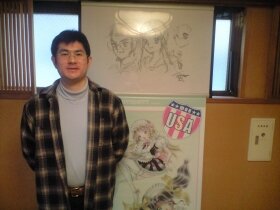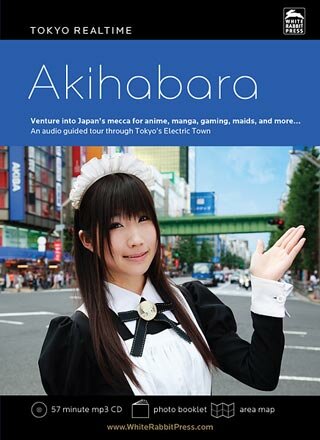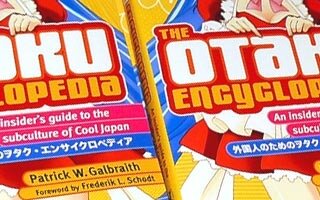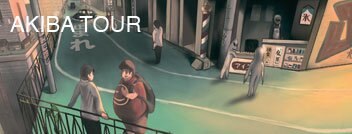 Filed under: Manga Moe USA Okura Atsuhisa Global
Filed under: Manga Moe USA Okura Atsuhisa GlobalOtaku2 Interview: Okura Atsuhisa
08.07.2008 by Patrick W. Galbraith
Hoping to no less than “educate and enlighten” the world on Japanese culture, Manga University, the publishing arm of the Japanime company established in 1998, planned a series of “wholesome” introductory manga on Akihabara, otaku maids and moe to be penned by Okura Atsuhisa, 39, a Kodansha Award laureate known for his work in the November 2007 edition of Wired. Given the current situation in Akihabara post-Kato massacre, the idyllic vision in Moe USA is more nostalgic than ever. With the third and final volume of coming soon, we decided to sit down with Okura to get to the bottom of the global move to educate otaku on Akihabara.
Why did you begin drawing manga?
Okura Atsuhisa: I loved manga and I learned that I could make enough money drawing it. I was a 19-year-old living in Tokyo and was reading manga magazines like mad. There are these ads inside soliciting submissions. My friends told me it was a decent way to make a little money, like as a part-time job. I wanted to be an artist and improve and share my work with others, so I gave it a try. I began writing for Business Jump, which has a slightly more adult readership. The style is hard-edged like American comic books. I received the Kodansha Award when I was 24, but I think it took me until I was 28 to really be recognized as a pro.
You went from Business Jump to Moe USA? What inspired you to this project?
OA: Foreigners are most interested in maids and Akihabara. These are the keys words. But it seems that there is a big gap between expectation and reality. Seeing maids and going to a maid cafÈ are completely different. So, I thought that if I made the maids manga then maybe I could make it easier to understand. Manga is the ideal medium to make difficult subjects manageable. That is the basic appeal of manga and why in principle it is perfect for teaching. I just applied it to new subjects in need of explanation and directed towards people in need of that information. Moe, maids, Akihabara, otaku, these are difficult topics in and of themselves, but as characters in a simple narrative it is intuitive. Moe USA is just a simple introduction, but perhaps it will provide enough information to get people interested in going deeper or expel misconceptions.
You call Akihabara an ‘otaku paradise.’ Can you explain what you mean?
OA: Akihabara used to be the Electric Town where appliances were cheap and abundant. Parts stores began to appear along with increasingly rare items. Otaku also gathered to use these parts to build machines. When computers arrived, the otaku exploded. Things that met their interests began to arrive in the market, manga, anime, cosplay, maids, dolls, you name it, the transition to otaku holyland progressed. I first went to Akihabara when no one was called otaku. The word didn’t exist, but anime and doujinshi were booming so we were called the “anime group.” I wasn’t interested in doujinshi because I didn’t want to pursue only my own desires, but rather write something that could be published and shared with others. It has been years since I was last in Akihabara, which might be a good thing. I draw my images from a kind of fantasy databank I have composed of the images I remember. They are not precisely accurate to the space of Akihabara today, but anyone who sees an image I drew instantly recognizes that it is Akihabara. I find it fascinating how we all somehow share the same conceptual image of the place. It is a fantasy. I drew that fantasy in my manga, a symbolic Akihabara that everyone knows. I hope everyone can enjoy it.
Your portrayal of otaku as kind and communal is unique. Is there any particular reason you chose that image in your work?
OA: Otaku have a maniac personality, but many people would like to be a little more like the otaku in Moe USA, a little more cool and respected. Otaku have a very negative image in Japan, even today. A media otaku and a real otaku are different and most people avoid the latter. I wanted to draw an otaku character that was very cool and kind to challenge popular stereotypes. The main otaku, Tanaka, seems like a classic otaku, but once we get to know him he is completely different. There are many kinds of otaku from good to bad – it is deep in so many ways that I hesitate to generalize. But the more you talk to otaku the more you see them as humans and the more you like them. It is a common pattern that I demonstrated through Tanaka. Yes, he is social. Otaku are, too, if you think of their Internet communities. There is something called ofukai, or off parties, where otaku who meet online and share interests meet in real life and become friends. It is common in Akihabara.
Patty and Ruby, the main characters of Moe USA, are presented as “all-American” girls who live for cosplay and worship Akihabara and otaku. Do you find them representative of foreign fans?
OA: Well, in a way it is inevitable that I used foreign characters as this is written for a foreign audience and it makes it easier to identify with the characters and learn with them. The reader may have similar experiences as Patty and Ruby or want to. It couldn’t be a Japanese yearning for cosplay and learning about maids – Japanese girls have been aware of these things for a long time. I wanted this to be for people experiencing Akihabara for the first time who are interested in the manga’s topics but need more information. Like Patty and Ruby. More and more foreigners are visiting, coming or moving to Akihabara. They are well represented in the cosplay going on during weekends. I think foreigners do feel like Patty and Ruby, kind of star struck and confused. This is a real otaku and this is the real Akihabara! It is like a dream. Isn’t it the same for Japanese in New York City seeing Time’s Square? I remember when I went to Florida, my first thought was, “Wow, the streets are so wide and there are American flags fluttering in the breeze! This is America.” It was my image of the place right in front of me and I was moved.
Moe is a big part of your vision of Akihabara. Can you explain what it means to you?
OA: Moe means I like this more than anything else. When it is a feeling exceeding just liking something, then it is moe. Moe is blossoming. When the leaves on the mountainside suddenly bud, everything becomes a lovely shade of green. That is moe. I think if you try to think of moe as the same kind of thing, but as a feeling, then you understand. That feeling is all over Akihabara. Maybe people coming here moe for Akihabara?
Do you think otaku in Japan and overseas see moe the same way?
OA: No, it is dark and light. What I mean is that in Japan, moe is seen as a little shady and maybe scary, but it is bright and cheerful overseas. It is the same basic difference you see in understanding of Akihabara and otaku domestically and internationally. Foreigners do not feel embarrassed when they come to Akihabara and so they can do what they want to believing it is right. They are free and happy. I once saw an older man, maybe 70, snapping shots of a maid in Akihabara. He was delighted with moe and didn’t care how he appeared to others. For foreigners that is what cosplay and moe is, a carnival that allows them to express freely. Japanese have liked matsuri, or festivals, for a long time, but now foreigners are coming to understand those joys. It is still new and fun, where the freshness of the play is a bit jaded in Japan now. It is the same as that festival element of Akihabara, in a way. Foreigners are coming in from the outside not knowing and so it is fresh and fun. They see it the way they imagined it, the way I tried to draw it. It is the same for people coming to Akihabara with discrimination in their hearts seeing it in a negative way. The images we have of the place without knowing it are the way we inevitably see it. I hope to add some positive images to give Akihabara a chance.
What is the future of Akihabara?
OA: The flow is different now. Things are moving away from otaku towards IT buildings. The otaku won’t disappear, but Akihabara will change. It isn’t a town just for otaku anymore. But then again, it used to be the Electric Town and now maybe it will go back to that. The deep, shy otaku leave when everyone comes to Akihabara. They do not want to exposed. The bright and cheerful otaku will not disappear. Actually, I think they will come to be more understood and loved.
What do you see as happening to otaku in, and perhaps beyond, Akihabara?
OA: First, the cheerful, socialized otaku will increase, become better known and disperse beyond Akihabara. For example, it used to be uncool to like trains and the train museum in Akihabara was uncool. Now, the train museum in Omiya, Saitama is a popular date spot and tecchan, or train otaku, have relocated there. Omiya is the train holyland and otaku and normal people are enjoying it together. The hobby is cleaned up, moved out and mainstreamed and the otaku are thriving right along with it. I think Nakano Broadway is developing the same way for figure and toy otaku who gather there as an alternative to Akihabara. The otaku culture is too vast now to be contained in Akihabara, so it spreads and breaks up collecting popular support as it does. So, the bright, cheerful otaku will dominant Akihabara, the more serious groups will carve out spaces elsewhere, the culture will specialize and diversify and mainstream and popular support will grow. Of course the global impact will continue to be felt. Foreign fans are very savvy with the Net and they will use it to track and follow the otaku as they grow, change and move.
What is your part in all this? Is “Moe USA in Nakano” coming up?
OA: No, I will continue to write about Akihabara for now. The third volume, expected to be the last, is scheduled for winter 2008. I will finally have an assistant on that one! Anyway, when you think of otaku you still imagine Akihabara. It is deeply ingrained and won’t change in the popular imagination. I would like to introduce other places and cultures, but as long as no one knows or loves them the way they do Akihabara then no one will buy the manga and I can’t afford to keep drawing them. If people want to know more about otaku and moe, I can go so much deeper with the topics developed in Japan. But I am afraid that people might not be ready for the darker side of otaku yet. I can’t draw for myself, just the things I want to see or do. I draw for foreigners and so must look at Akihabara through their eyes.
Thank you for your time today. Is there anything you would like to say to readers?
OA: Well, I was watching 24, Heroes and other American TV shows when I was working on some of the stories in Moe USA Vol. 2, so I hope you will enjoy the way the stories develop and unfold. I am very inspired by American TV dramas! They have the best characters and stories. If I was able to incorporate that into moe a little I am happy.
Comment on this article

07.02.2010 · Features
Temple University Japan offers program in popular culture
Roland Kelts teaching anime, Patrick W. Galbraith manga
15.01.2010 · Blog
Tsutaya is renting manga
This really is going to be a happy new year! Tsutaya, Japan's largest chain of rental video stores, is now carrying manga. Lots of it. They...
11.08.2009 · Reviews
Mospeada Complete Art Works Book Review
The Mospeada Complete Art Works book just hit bookstores in Japan this past Saturday August 8th. It’s the eighth volume in the...
30.06.2009 · Blog
Kashihonya still exist!
And here I thought these were all gone! This one is in Kunitachi way out on the Chuo Line. Still in business, even with all the online...
23.04.2009 · Blog
Reading English manga turns heads on Japanese subways.
In the last four years I've hand many friends from overseas stay at my house when they come to visit me in Tokyo. Most buy more stuff than...
07.03.2009 · Blog
Congratulations Jamie!!!!
It's so wonderful to see friends making their dreams a reality. On my way to work the local 7/11 had the new issue of Jump Square featuring...



























2 CommentsComment Page 1 of 1
Rodney King wrote on 20.7.2008:
Can't we all just get along? :-)
In rebuttal to "Major Problems":
No country is perfect, and I will agree that a lot of Otaku, especially American Otaku, idealize Japan and put the country and culture on a pedestal. They dream of an idyllic society where everyone bows, everyone is polite, and all the women are subservient to men. It is a skewed view and anyone who buys into that is seriously misguided and needs to be educated.
Everyone likes to point the finger at Japan for Nanking, which was a horrible atrocity no doubt, but you can turn around and look at China and their actions towards Tibet. All countries all over the world have someone's blood on their hands.
Where Major Problems logic is flawed is in this statement: "Japanese hate blacks and hispanics greatly." To make a blanket statement like that promotes the type of racism that Major Problems is claiming to want to overcome. To say that otaku are acting like "pure savages?" Please. Warps minds? Where is your proof? And please don't point to the tired examples of Aum Shinrikyo or the more recent Akihabara massacre. Those were isolated incidents of either a brainwashing cult which used psychotropic drugs to control the minds of its followers, or a very mentally unbalanced man who just so happened to read manga.
How are American or Non-Japanese Otaku "emulating Japan or its ppl [sic]"? To watch anime or read manga is hardly a way to emulate an entire culture.
"Diversity of people should be embraced and accepted." Agreed. The fact that Americans are embracing the culture of Japan is only the beginning. Racism is fought with patience, education, and understanding. Accusing an ENTIRE CULTURE of hating Blacks and Hispanics is not the way to promote this diversity you seek. Change takes time. The Japanese have a saying, "nothing changes in Japan." That is because it is a culture that is centuries old that has been doing certain things in certain ways for ages. The concept of "wa" (complete harmony) is a teaching that has been ingrained into the society since the late 6th/early 7th century. The Japanese feel that only other Japanese can appreciate and understand this group harmony. That is why there is an underlying "racism" which is not racism in as much as a belief that ANY other culture besides Japanese can't grasp this concept, because of language barriers, cultural barriers, etc. The fact that Japan is an island and Mono-ethnic nation also helps foster and promote this belief, as geography and language barriers have slowed the influx of other cultures. It will take patience and time of non-Japanese to learn the language and culture, and to prove that anyone can grasp this enlightened concept, given time. This will help to change the way Japanese see other races.
As the youth in Japan grow older the old ways will change. Proof: Younger kids in Japan like American culture, slang, using English is thought of as "cool," clothing styles are copied and given a Japanese twist, etc. They are emulating a culture that, just 50 years prior, obliterated Hiroshima and Nagasaki in the worst nuclear attack in world history. If the Japanese can look past this and accept and embrace Americans as tourists and as working residents, then the best we can do is understand their views, why they think the way they do, and do our best through education to affect social change.
Finally, is insulting Japanese and otaku on an otaku website focused on anime and otaku culture really the best place to try and spark this debate?
Major Problems wrote on 14.7.2008:
I believe there is a major problem with people enamored with japan and otakus in general... You see it is ok to like the entertainment or pop culture of another country or region but it is not always ok to adopt the attitudes of that nation or region and heres why...
Japan has and always will be a very racially prejudiced country, you see it in their history in WWII how they thought themselves superior to other ppl and other races and invaded china in the rape of nanking. These barbaric acts and attitudes are very much alive in japan today... Japanese hate blacks and hispanics greatly.
They make fun of people that are different or minorities to them and pick on them and thats not cool... and the foreign white and asian otaku are acting just like them... pure savages, this is why the otaku culture is dangerous... it warps and twists peoples minds so that they are no longer lovable human beings.
Please people don't emulate Japan or its ppl, diversity of people should be embraced and accepted. and the freedom to express yourself must have its limits...
I know its hard to fight the prejudice feeling inside us but it is possible to fight those traits and become better people... people just have to want to change.